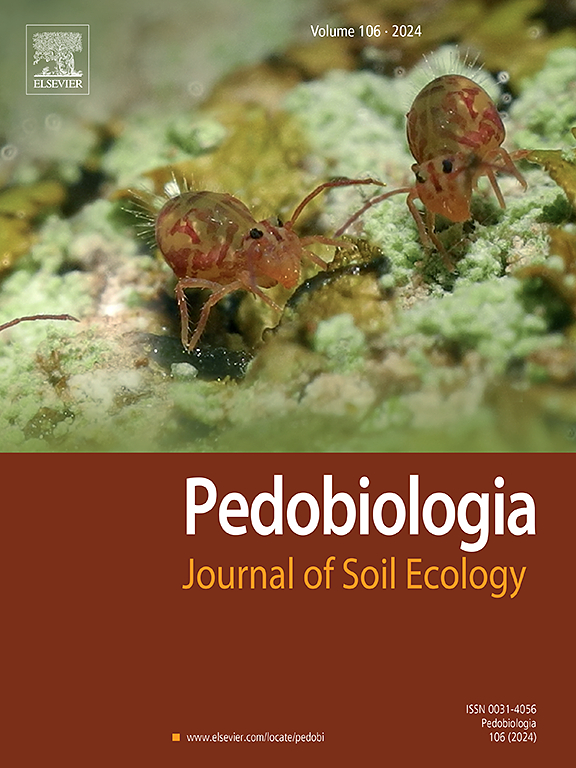Lesser periwinkle (Vinca minor L.) invasion alters the composition of soil invertebrate communities in two mixed deciduous forests
IF 2.2
3区 农林科学
Q3 ECOLOGY
引用次数: 0
Abstract
Invasive plant species threaten biodiversity and ecosystem stability, yet their impacts on soil invertebrate communities remain understudied globally. Vinca minor L. (common name: Lesser periwinkle) is an aggressive groundcover invasive plant widely distributed in North America, yet its ecological consequences for belowground fauna are mainly unknown. This study aimed to assess whether V. minor invasion alters soil invertebrate community composition, richness, and abundance in two forested ecosystems in Canada. We conducted a field study across two forested sites, sampling soil invertebrates from naturally invaded and uninvaded plots (n = 40). Invertebrates were extracted using Berlese-Tullgren funnels, identified to morphospecies, and analyzed for changes in abundance, richness, and community composition using Generalized Linear Models, Permanova, and distance-based redundancy analysis (db-RDA). We identified 1183 invertebrates across 12 taxonomic groups, including mites (Oribatida, Mesostigmata, Prostigmata), springtails, annelids, isopods, and arachnids. Invertebrate richness but not abundance was lower in invaded plots than in uninvaded plots, albeit not significantly. For example, spider presence was significantly reduced in invaded plots (p = 0.027). Vinca minor invasion significantly altered community composition (Permanova, p = 0.006), with greater dissimilarity among invaded plots. Db-RDA confirmed that site location and V. minor invasion were key drivers of soil invertebrate community variation. Our findings suggest that V. minor invasion modifies soil invertebrate community structure. Given the widespread distribution of V. minor in North America, its ecological impacts on soil biodiversity raise concerns about potential species losses and alterations in ecosystem processes.
小长春花入侵改变了两种混交林土壤无脊椎动物群落的组成
植物入侵威胁着生物多样性和生态系统的稳定性,但其对土壤无脊椎动物群落的影响在全球范围内仍未得到充分研究。长春花(俗称:小长春花)是一种广泛分布于北美的侵略性地被入侵植物,但其对地下动物的生态影响尚不清楚。本研究旨在评估小弧菌入侵是否会改变加拿大两个森林生态系统土壤无脊椎动物群落组成、丰富度和丰度。我们在两个森林站点进行了实地研究,从自然入侵和未入侵的样地取样土壤无脊椎动物(n = 40)。利用Berlese-Tullgren漏斗提取无脊椎动物,鉴定形态种,并利用广义线性模型、Permanova和基于距离的冗余分析(db-RDA)分析其丰度、丰富度和群落组成的变化。共鉴定出12个类群1183只无脊椎动物,包括螨类(恙螨目、中鞭毛虫目、前鞭毛虫目)、弹尾类、链接类、等足类和蛛形类。入侵样地无脊椎动物丰富度低于未入侵样地,但差异不显著。例如,蜘蛛的存在在入侵地块显著减少(p = 0.027)。长春花轻微入侵显著改变了群落组成(Permanova, p = 0.006),不同入侵样地间差异较大。Db-RDA证实了立地位置和小v入侵是土壤无脊椎动物群落变异的关键驱动因素。研究结果表明,小弧菌的入侵改变了土壤无脊椎动物群落结构。鉴于小紫草在北美的广泛分布,其对土壤生物多样性的生态影响引起了人们对潜在物种损失和生态系统过程改变的关注。
本文章由计算机程序翻译,如有差异,请以英文原文为准。
求助全文
约1分钟内获得全文
求助全文
来源期刊

Pedobiologia
环境科学-生态学
CiteScore
4.20
自引率
8.70%
发文量
38
审稿时长
64 days
期刊介绍:
Pedobiologia publishes peer reviewed articles describing original work in the field of soil ecology, which includes the study of soil organisms and their interactions with factors in their biotic and abiotic environments.
Analysis of biological structures, interactions, functions, and processes in soil is fundamental for understanding the dynamical nature of terrestrial ecosystems, a prerequisite for appropriate soil management. The scope of this journal consists of fundamental and applied aspects of soil ecology; key focal points include interactions among organisms in soil, organismal controls on soil processes, causes and consequences of soil biodiversity, and aboveground-belowground interactions.
We publish:
original research that tests clearly defined hypotheses addressing topics of current interest in soil ecology (including studies demonstrating nonsignificant effects);
descriptions of novel methodological approaches, or evaluations of current approaches, that address a clear need in soil ecology research;
innovative syntheses of the soil ecology literature, including metaanalyses, topical in depth reviews and short opinion/perspective pieces, and descriptions of original conceptual frameworks; and
short notes reporting novel observations of ecological significance.
 求助内容:
求助内容: 应助结果提醒方式:
应助结果提醒方式:


